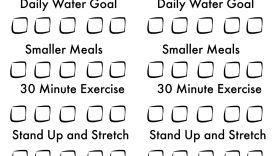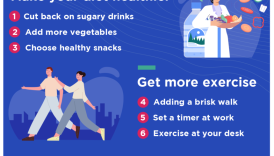Achieving Balance: The Roadmap to Healthy Living

Importance of Balance in Healthy Living
Leading a healthy life is not just about eating right or exercising regularly; it’s about achieving a harmonious balance among various aspects of life. Many people may focus on physical health, neglecting mental well-being and social connections, which are equally vital. For instance, an individual might spend hours in the gym but find themselves feeling stressed and isolated, ultimately undermining their efforts. Striking a balance helps to:
- Achieving Balance: The Roadmap to Healthy Living
- Importance of Balance in Healthy Living
- Understanding the Components of a Healthy Lifestyle
- Physical Health
- Mental Health
- Setting Realistic Health Goals
- Nutrition
- Exercise
- Managing Stress Effectively
- Mindfulness and Meditation
- Time Management
- Building Supportive Relationships
- Social Connections
- Communication Skills
- Prioritizing Self-Care
- Sleep
- Relaxation Techniques
- Finding Joy in Everyday Life
- Hobbies and Interests
- Gratitude Practices
- Balancing Work and Personal Life
- Work-Life Boundaries
- Time for Leisure
- Incorporating Mindfulness into Daily Routine
- Mindful Eating
- Mindful Movement
- Seeking Professional Help When Needed
- Therapy and Counseling
- Medical Consultation
- Embracing a Holistic Approach to Wellness
- Body-Mind Connection
- Spiritual Wellbeing
- Enhance overall well-being
- Reduce stress levels
- Improve productivity and creativity
- Foster better relationships
Consider someone who enjoys hiking but also loves cooking healthy meals and practicing yoga. Each of these activities contributes uniquely to their health, showing that balance is key. By nurturing all areas of life, one can achieve a more fulfilling, sustainable approach to wellness.
Understanding the Components of a Healthy Lifestyle
Physical Health
Physical health serves as the foundation for a healthy lifestyle. Regular exercise, a balanced diet, and adequate sleep are crucial components to maintaining vitality. For example, consider a busy parent juggling work and family—making time for brisk walks or weekend bike rides can keep energy levels high while providing quality bonding time. To prioritize physical health, one might focus on:
- Exercise: Aim for at least 150 minutes of moderate activity weekly.
- Nutrition: Fill your plate with fruits, vegetables, lean proteins, and whole grains.
Mental Health
Equally important is mental health, which can significantly influence overall well-being. Practicing self-care, managing stress levels, and cultivating positive mindsets are vital. A personal example might be setting aside “me time” each week to engage in hobbies or unwind with a good book. To boost mental health, aim for:
- Mindfulness Practices: Incorporate meditation or deep-breathing exercises.
- Social Connections: Spend time with loved ones to foster support and understanding.
By nurturing both physical and mental health, individuals can create a balanced and rewarding lifestyle.
Setting Realistic Health Goals
Nutrition
After understanding the fundamental components of health, it’s essential to focus on setting realistic health goals, beginning with nutrition. Striving for a balanced diet doesn’t mean vowing to eliminate every indulgent food. Instead, start small—like replacing sugary snacks with fruit or planning weekly meals. For example, a busy college student might aim to prep healthy lunches every Sunday, making it easier to eat well throughout the week. Here are a few tips to set effective nutrition goals:
- Be Specific: Instead of “eat healthier,” aim for “include vegetables in every meal.”
- Set Measurable Goals: Commit to drinking eight glasses of water daily.
Exercise
Equally vital is setting achievable exercise goals. Rather than committing to a daily gym session right away, consider integrating physical activity into your routine gradually. A professional practicing law might decide to walk for 20 minutes during their lunch break instead. To help establish exercise goals, consider:
- Realistic Timeframes: Aim for three workout sessions a week rather than committing to daily workouts from the start.
- Variety: Mix recommendations by trying different activities—yoga, cycling, or group classes—to keep it enjoyable.
Creating realistic nutrition and exercise goals fosters sustainable habits that pave the way for long-term health.
Managing Stress Effectively
Mindfulness and Meditation
As we set realistic health goals in nutrition and exercise, it’s crucial to address an often-overlooked aspect—stress management. Mindfulness and meditation can offer powerful tools to combat daily stressors. For instance, taking just ten minutes each morning to practice deep breathing or focus on positive affirmations can set a calming tone for the day ahead. To incorporate mindfulness practices, consider:
- Meditate Daily: Start with guided sessions available through apps or online videos.
- Practice Gratitude: Spend a moment each evening reflecting on three things you’re grateful for.
Time Management
Effective time management can also alleviate stress. When life feels overwhelming, it’s easy to neglect priorities. A writer juggling multiple deadlines found that creating a daily schedule transformed their productivity. Here are a few strategies for better time management:
- Prioritize Tasks: Use a do-list or planner to rank what needs your attention first.
- Set Boundaries: Clearly define work hours to carve out personal time.
By implementing mindfulness and mastering time management, individuals can significantly reduce stress and enhance their overall well-being.
Building Supportive Relationships
Social Connections
Continuing from stress management, nurturing supportive relationships is vital for emotional well-being. Social connections can provide strength during tough times and enhance joy in everyday life. For example, a woman who regularly meets with friends for a weekly dinner has found that these gatherings are a source of laughter and support, helping her navigate life’s challenges. To strengthen social connections, consider:
- Joining Groups: Participate in clubs or community events that align with your interests.
- Reaching Out: Don’t hesitate to connect with old friends or family; a simple phone call can rekindle meaningful bonds.
Communication Skills
Equally important is honing communication skills, which can significantly enhance relationships. Open and honest dialogue fosters understanding and trust. For instance, a colleague who practices active listening during discussions often finds that conflicts resolve more easily. To improve communication skills, try:
- Active Listening: Focus entirely on the speaker without interrupting.
- Expressing Yourself Clearly: Use “I” statements to share feelings without sounding accusatory.
By investing in social connections and developing strong communication skills, individuals can create a network of support that enriches their lives.
Prioritizing Self-Care
Sleep
As we explore the importance of building supportive relationships, let’s shift our focus to prioritizing self-care, which is essential for maintaining overall health. One of the most overlooked aspects of self-care is sleep. Restful nights can significantly improve mood, cognitive function, and physical health. For example, a busy student who ensures they get at least seven hours of sleep each night finds they perform better academically and feel more energized. Here are a few tips for improving sleep quality:
- Establish a Routine: Go to bed and wake up at the same time every day.
- Create a Sleep-Friendly Environment: Keep the bedroom dark, quiet, and cool.
Relaxation Techniques
In addition to sleep, incorporating relaxation techniques can further enhance self-care. Activities like yoga, deep breathing, or journaling can help quiet the mind and reduce anxiety. A working professional might spend just five minutes a day practicing these techniques and feel noticeably calmer. To incorporate relaxation into your routine, consider:
- Guided Meditation: Use an app to practice mindfulness and find inner peace.
- Gentle Stretching: Take breaks to stretch during the day, releasing tension in the body.
By prioritizing sleep and embedding relaxation techniques, individuals can foster a rejuvenating self-care practice that supports their mental and physical health.
Finding Joy in Everyday Life
Hobbies and Interests
After establishing a solid self-care routine, the next step is finding joy in everyday life. Engaging in hobbies and interests is a powerful way to bring happiness into daily routines. For example, a man who loves painting can find solace and fulfillment in creating art, even if it’s just for an hour each week. To discover or rekindle hobbies, consider:
- Exploring New Activities: Try out cooking classes, photography, or gardening to see what resonates.
- Scheduling Time for Fun: Block out time in your calendar for hobbies to make them a priority.
Gratitude Practices
Another effective way to cultivate joy is through gratitude practices. Reflecting on what one is thankful for can shift focus from challenges to positivity. A woman who keeps a gratitude journal finds that jotting down three things she appreciates each night helps her end the day on a high note. Here are simple gratitude practices to incorporate:
- Daily Affirmations: Start your day by affirmatively stating what you’re thankful for.
- Gratitude Jar: Write down moments of gratitude on slips of paper and place them in a jar for reflection later.
By actively engaging in hobbies and nurturing gratitude, individuals can uncover joy in their everyday experiences, enriching their lives.
Balancing Work and Personal Life
Work-Life Boundaries
With joy and fulfillment in everyday life, it’s crucial to address balancing work and personal life. Establishing clear work-life boundaries is essential in maintaining overall well-being. For instance, a marketing executive who sets specific working hours often finds that disconnecting after hours helps decrease burnout and improve productivity the next day. To create effective boundaries, consider:
- Designating a Workspace: Set up a specific area for work to keep it separate from personal spaces.
- Communicating Boundaries: Inform colleagues of your availability to help reinforce expectations.
Time for Leisure
Equally important is carving out time for leisure. After a long day at work, making time for activities that rejuvenate the mind and body can significantly improve life satisfaction. A busy parent may schedule family game nights or weekend hikes to enjoy shared experiences. To prioritize leisure:
- Plan Weekly Activities: Schedule fun outings or relaxation time just like any other appointment.
- Unplug Regularly: Set aside screen-free time to engage fully in leisure activities with loved ones.
By establishing work-life boundaries and allowing time for leisure, individuals can create a harmonious balance that enriches both personal and professional lives.
Incorporating Mindfulness into Daily Routine
Mindful Eating
As we strive to balance work and personal life, incorporating mindfulness into our daily routines can further enhance well-being. Mindful eating is a powerful practice that encourages individuals to savor each bite and appreciate the entire experience of their meals. For example, someone who sets aside distractions and takes the time to enjoy their food often finds meals more satisfying and can even experience better digestion. To practice mindful eating, try these tips:
- Eat Slowly: Take time to chew each bite thoroughly and enjoy the flavors.
- Limit Distractions: Put away phones or turn off the TV during meals.
Mindful Movement
Another effective mindfulness practice is mindful movement. This involves being fully present and engaged in physical activities, whether it’s a walk, yoga, or dancing. A friend who practices mindfulness during her evening walks often takes notice of the beauty around her, feeling more connected to nature. To incorporate mindful movement:
- Focus on Sensations: Pay attention to how your body feels during exercise.
- Breathe Deeply: Synchronize your breath with each movement to enhance awareness.
By integrating mindful eating and movement into daily routines, individuals can cultivate a deeper appreciation for the present moment, enriching both their physical and mental health.
Seeking Professional Help When Needed
Therapy and Counseling
As we incorporate mindfulness into our routines, it’s essential to recognize the importance of seeking professional help when needed. Therapy and counseling can provide invaluable support for anyone navigating mental health challenges. For instance, an individual who faced anxiety found that regular therapy sessions equipped them with coping strategies and a safe space to express feelings. To consider therapy, here are a few points to remember:
- Find the Right Match: Look for a therapist who specializes in your concerns and whom you feel comfortable with.
- Regular Sessions: Set a consistent schedule to maximize benefits.
Medical Consultation
In addition to therapy, medical consultation may be necessary, especially when physical symptoms arise. A friend experiencing chronic fatigue discovered that a visit to a healthcare provider led to the diagnosis of an underlying health issue. When considering a medical consultation, keep in mind:
- Be Prepared: Document any symptoms you’re experiencing to share with your doctor.
- Follow Up: Don’t hesitate to ask questions or seek second opinions if needed.
By acknowledging when to seek professional help, individuals can access support and resources that enhance their overall health and well-being.
Embracing a Holistic Approach to Wellness
Body-Mind Connection
As we recognize the importance of seeking professional help, the next step in enhancing our well-being is embracing a holistic approach to wellness. A vital aspect of this approach is the body-mind connection, which highlights how our mental state can significantly impact physical health. For example, an individual under severe stress may experience headaches or fatigue, illustrating the interplay between mind and body. To nurture this connection, consider:
- Practice Relaxation Techniques: Activities like yoga and tai chi can harmonize physical movement and mental focus.
- Stay Attuned to Your Body: Listen to physical cues; they may signal emotional stress that needs addressing.
Spiritual Wellbeing
Equally crucial is fostering spiritual well-being, which can provide a sense of purpose and peace. Engaging in practices such as meditation, nature walks, or simply reflecting on personal beliefs can nurture this aspect. A colleague who spends time each week volunteering finds that helping others enhances their spiritual connection and leaves them feeling fulfilled. To prioritize spiritual well-being:
- Reflect on Personal Values: Make time to understand what truly matters to you.
- Connect with Nature: Spend time outdoors to foster a sense of grounding and connection to something larger.
By integrating awareness of the body-mind connection and nurturing spiritual wellness, individuals can embrace a comprehensive approach to their overall health and well-being.





